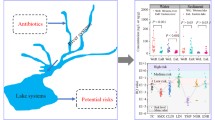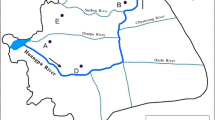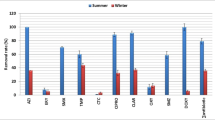Abstract
The occurrence and removal of 13 antibiotics were investigated in five wastewater treatment plants (WWTPs) with advanced wastewater treatment processes in Beijing, China. Most of the target antibiotics were detected in the secondary and tertiary effluents, with the concentrations of 4.8–1106.0 and 0.3–505.0 ng·L−1. Fluoroquinolone antibiotics showed relatively high concentrations in all samples (782–1814 ng·L−1). Different tertiary treatment processes showed discrepant antibiotics removal performances. Ozonation process was found more effective in removing target antibiotics compared to the coagulation-flocculation-sedimentation process and sand filtration process. Investigation of the target antibiotics in three typical urban rivers in Beijing was carried out to understand antibiotics occurrence in surface water environment. Eight antibiotics were detected in the studied rivers, with highest concentration of antibiotics in the river which was mainly replenished by reclaimed water. This study showed the necessity of employing more effective advanced treatment facilities to further reduce the discharge amount of antibiotics.
Similar content being viewed by others
References
Jones O A, Voulvoulis N, Lester J N. The occurrence and removal of selected pharmaceutical compounds in a sewage treatment works utilising activated sludge treatment. Environmental Pollution, 2007, 145(3): 738–744
Rosal R, Rodríguez A, Perdigón-Melón J A, Petre A, Garcóa-Calvo E, Gümez M J, Agüera A, Fernández-Alba A R. Occurrence of emerging pollutants in urban wastewater and their removal through biological treatment followed by ozonation. Water Research, 2010, 44(2): 578–588
Jelic A, Gros M, Ginebreda A, Cespedes-Sánchez R, Ventura F, Petrovic M, Barcelo D. Occurrence, partition and removal of pharmaceuticals in sewage water and sludge during wastewater treatment. Water Research, 2011, 45(3): 1165–1176
Xue B, Zhang R, Wang Y, Liu X, Li J, Zhang G. Antibiotic contamination in a typical developing city in south China: occurrence and ecological risks in the Yongjiang River impacted by tributary discharge and anthropogenic activities. Ecotoxicology and Environmental Safety, 2013, 92: 229–236
Kleywegt S, Pileggi V, Yang P, Hao C, Zhao X, Rocks C, Thach S, Cheung P, Whitehead B. Pharmaceuticals, hormones and bisphenol A in untreated source and finished drinking water in Ontario, Canada—occurrence and treatment efficiency. Science of the Total Environment, 2011, 409(8): 1481–1488
Watkinson A J, Murby E J, Costanzo S D. Removal of antibiotics in conventional and advanced wastewater treatment: implications for environmental discharge and wastewater recycling. Water Research, 2007, 41(18): 4164–4176
Jia A, Wan Y, Xiao Y, Hu J. Occurrence and fate of quinolone and fluoroquinolone antibiotics in a municipal sewage treatment plant. Water Research, 2012, 46(2): 387–394
Zhou L J, Ying G G, Liu S, Zhao J L, Yang B, Chen Z F, Lai H J. Occurrence and fate of eleven classes of antibiotics in two typical wastewater treatment plants in South China. Science of the Total Environment, 2013, 452–453: 365–376
Huber M M, Göbel A, Joss A, Hermann N, Löffler D, McArdell C S, Ried A, Siegrist H, Ternes T A, von Gunten U. Oxidation of pharmaceuticals during ozonation of municipal wastewater effluents: a pilot study. Environmental Science and Technology, 2005, 39(11): 4290–4299
Huber M M, Korhonen S, Ternes T A, von Gunten U. Oxidation of pharmaceuticals during water treatment with chlorine dioxide. Water Research, 2005, 39(15): 3607–3617
Lee Y, von Gunten U. Oxidative transformation of micropollutants during municipal wastewater treatment: comparison of kinetic aspects of selective (chlorine, chlorine dioxide, ferrate VI, and ozone) and non-selective oxidants (hydroxyl radical). Water Research, 2010, 44(2): 555–566
Wang P, He Y L, Huang C H. Reactions of tetracycline antibiotics with chlorine dioxide and free chlorine. Water Research, 2011, 45(4): 1838–1846
Nakada N, Shinohara H, Murata A, Kiri K, Managaki S, Sato N, Takada H. Removal of selected pharmaceuticals and personal care products (PPCPs) and endocrine-disrupting chemicals (EDCs) during sand filtration and ozonation at a municipal sewage treatment plant. Water Research, 2007, 41(19): 4373–4382
Ternes T A, Stüber J, Herrmann N, McDowell D, Ried A, Kampmann M, Teiser B. Ozonation: a tool for removal of pharmaceuticals, contrast media and musk fragrances from wastewater? Water Research, 2003, 37(8): 1976–1982
Xu W, Zhang G, Li X, Zou S, Li P, Hu Z, Li J. Occurrence and elimination of antibiotics at four sewage treatment plants in the Pearl River Delta (PRD), South China. Water Research, 2007, 41(19): 4526–4534
Zhang H, Liu P, Feng Y, Yang F. Fate of antibiotics during wastewater treatment and antibiotic distribution in the effluentreceiving waters of the Yellow Sea, northern China. Marine Pollution Bulletin, 2013, 73(1): 282–290
Li W, Shi Y, Gao L, Liu J, Cai Y. Occurrence and removal of antibiotics in a municipal wastewater reclamation plant in Beijing, China. Chemosphere, 2013, 92(4): 435–444
Tong C, Zhuo X, Guo Y. Occurrence and risk assessment of four typical fluoroquinolone antibiotics in raw and treated sewage and in receiving waters in Hangzhou, China. Journal of Agricultural and Food Chemistry, 2011, 59(13): 7303–7309
Zorita S, Märtensson L, Mathiasson L. Occurrence and removal of pharmaceuticals in a municipal sewage treatment system in the south of Sweden. Science of the Total Environment, 2009, 407(8): 2760–2770
Vieno N M, Härkki H, Tuhkanen T, Kronberg L. Occurrence of pharmaceuticals in river water and their elimination in a pilot-scale drinking water treatment plant. Environmental Science and Technology, 2007, 41(14): 5077–5084
Gracia-Lor E, Sancho J V, Serrano R, Hernández F. Occurrence and removal of pharmaceuticals in wastewater treatment plants at the Spanish Mediterranean area of Valencia. Chemosphere, 2012, 87(5): 453–462
Karthikeyan K G, Meyer M T. Occurrence of antibiotics in wastewater treatment facilities in Wisconsin, USA. Science of the Total Environment, 2006, 361(1–3): 196–207
Behera S K, Kim H W, Oh J E, Park H S. Occurrence and removal of antibiotics, hormones and several other pharmaceuticals in wastewater treatment plants of the largest industrial city of Korea. Science of the Total Environment, 2011, 409(20): 4351–4360
Yang X, Flowers R C, Weinberg H S, Singer P C. Occurrence and removal of pharmaceuticals and personal care products (PPCPs) in an advanced wastewater reclamation plant. Water Research, 2011, 45(16): 5218–5228
Wang H. Ozone kinetics of dimethyl sulfide in the presence of water vapor. Frontiers of Environmental Science and Engineering, 2013, 7(6): 833–835
Nakada N, Kiri K, Shinohara H, Harada A, Kuroda K, Takizawa S, Takada H. Evaluation of pharmaceuticals and personal care products as water-soluble molecular markers of sewage. Environmental Science and Technology, 2008, 42(17): 6347–6353
Ikehata K, Gamal El-Din M, Snyder S A. Ozonation and advanced oxidation treatment of emerging organic pollutants in water and wastewater. Ozone Science and Engineering, 2008, 30(1): 21–26
Sui Q, Huang J, Deng S, Yu G, Fan Q. Occurrence and removal of pharmaceuticals, caffeine and DEET in wastewater treatment plants of Beijing, China. Water Research, 2010, 44(2): 417–426
Hey G, Grabic R, Ledin A, La Cour Jansen J, Andersen H. Oxidation of pharmaceuticals by chlorine dioxide in biologically treated wastewater. Chemical Engineering Journal, 2012, 185: 236–242
Batt A L, Kim S, Aga D S. Comparison of the occurrence of antibiotics in four full-scale wastewater treatment plants with varying designs and operations. Chemosphere, 2007, 68(3): 428–435
Adams C, Wang Y, Loftin K, Meyer M. Removal of antibiotics from surface and distilled water in conventional water treatment processes. Journal of Environmental Engineering, 2002, 128(3): 253–260
Canonica S, Meunier L, von Gunten U. Phototransformation of selected pharmaceuticals during UV treatment of drinking water. Water Research, 2008, 42(1–2): 121–128
Xu W H, Zhang G, Zou S C, Li X D, Liu Y C. Determination of selected antibiotics in the Victoria Harbour and the Pearl River, South China using high-performance liquid chromatographyelectrospray ionization tandem mass spectrometry. Environmental Pollution, 2007, 145(3): 672–679
Löffler D, Ternes T A. Determination of acidic pharmaceuticals, antibiotics and ivermectin in river sediment using liquid chromatography-tandem mass spectrometry. Journal of Chromatography A, 2003, 1021(1–2): 133–144
Beausse J. Selected drugs in solid matrices: a review of environmental determination, occurrence and properties of principal substances. Trends in Analytical Chemistry, 2004, 23(10–11): 753–761
Author information
Authors and Affiliations
Corresponding author
Rights and permissions
About this article
Cite this article
Li, X., Shi, H., Li, K. et al. Occurrence and fate of antibiotics in advanced wastewater treatment facilities and receiving rivers in Beijing, China. Front. Environ. Sci. Eng. 8, 888–894 (2014). https://doi.org/10.1007/s11783-014-0735-0
Received:
Accepted:
Published:
Issue Date:
DOI: https://doi.org/10.1007/s11783-014-0735-0




